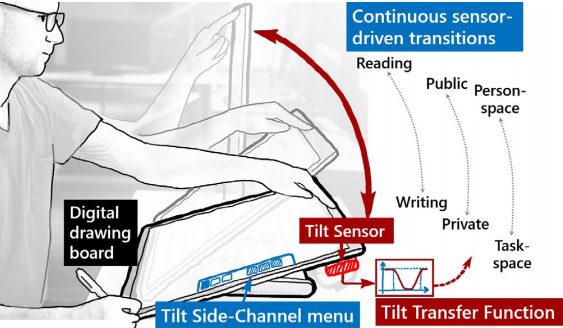
Contributors:
Hugo Romat, Christopher Collins, Nathalie Riche, Michel Pahud, Christian Holz, Adam Riddle, Bill Buxton, and Ken Hinckley
Drawing boards offer a self-stable work surface that is continuously adjustable. On digital displays, such as the Microsoft Surface Studio, these properties open up a class of techniques that sense and respond to tilt adjustments. Each display posture—whether angled high, low, or somewhere in-between—affords some activities, but not others. Because what is appropriate also depends on the application and task, we explore a range of app-specific transitions between reading vs. writing (annotation), public vs. personal, shared person-space vs. task-space, and other nuances of input and feedback, contingent on display angle. Continuous responses provide interactive transitions tailored to each use-case. We show how a variety of knowledge work scenarios can use sensed display adjustments to drive context-appropriate transitions, as well as technical software details of how to best realize these concepts. A preliminary remote user study suggests that techniques must balance the effort required to adjust the tilt, versus the potential benefits of a sensed transition.
Publications
-

H. Romat, C. Collins, N. Riche, M. Pahud, C. Holz, A. Riddle, B. Buxton, and K. Hinckley, “Tilt-Responsive Techniques for Digital Drawing Boards,” in UIST ’20: Proceedings of the 33rd Annual ACM Symposium on User Interface Software and Technology, 2020.
@InProceedings{col2020a,
author = {Hugo Romat and Christopher Collins and Nathalie Riche and Michel Pahud and Christian Holz and Adam Riddle and Bill Buxton and Ken Hinckley},
title = {Tilt-Responsive Techniques for Digital Drawing Boards},
booktitle = {UIST ’20: Proceedings of the 33rd Annual ACM Symposium on User Interface Software and Technology},
month = {October},
year = {2020},
publisher = {ACM},
}
